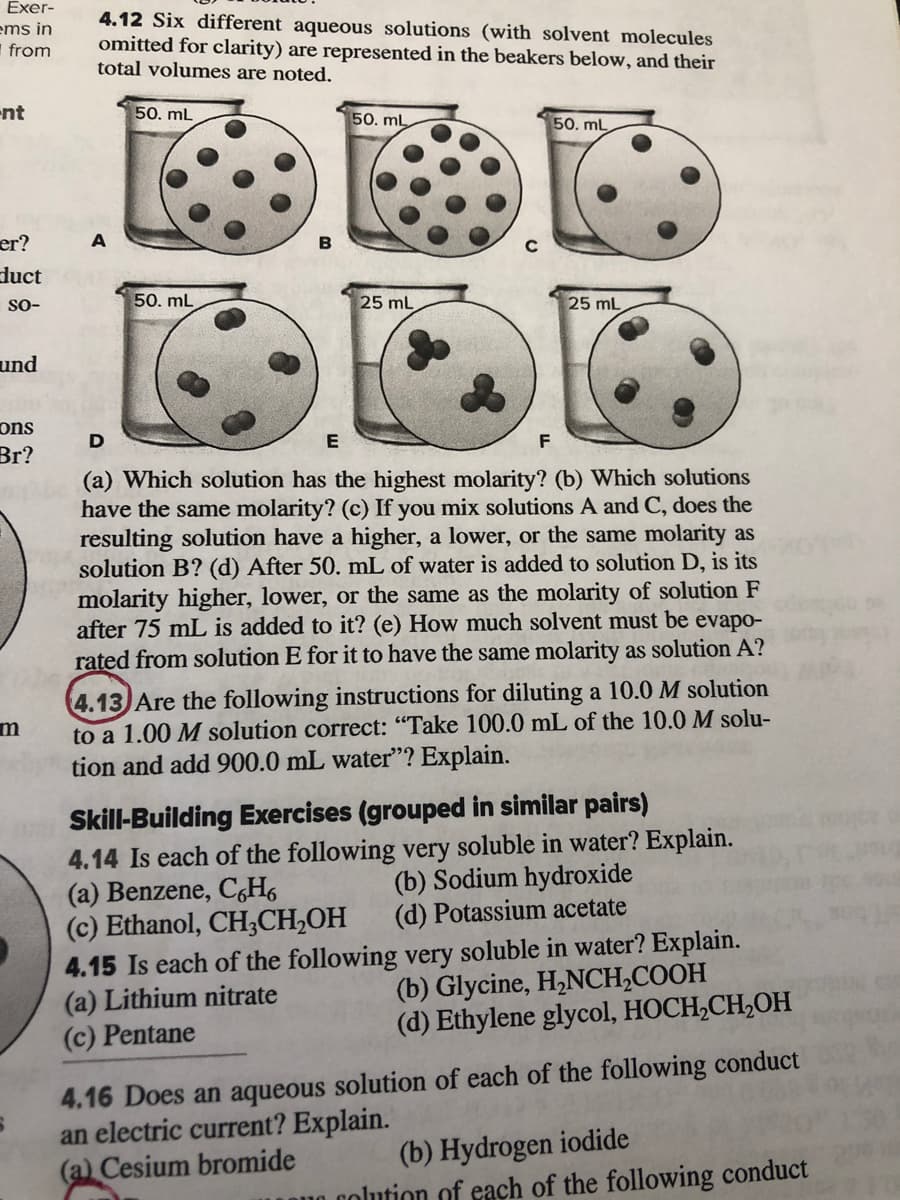4.13 Are the following instructions for diluting a 10.0 M solution to a 1.00 M solution correct: "Take 100.0 mL of the 10.0 M solu- tion and add 900.0 mL water"? Explain.
4.13 Are the following instructions for diluting a 10.0 M solution to a 1.00 M solution correct: "Take 100.0 mL of the 10.0 M solu- tion and add 900.0 mL water"? Explain.
Chemistry for Today: General, Organic, and Biochemistry
9th Edition
ISBN:9781305960060
Author:Spencer L. Seager, Michael R. Slabaugh, Maren S. Hansen
Publisher:Spencer L. Seager, Michael R. Slabaugh, Maren S. Hansen
Chapter7: Sollutions And Colloids
Section: Chapter Questions
Problem 7.2E
Related questions
Question
100%
Question 13 please

Transcribed Image Text:Exer-
ems in
I from
4.12 Six different aqueous solutions (with solvent molecules
omitted for clarity) are represented in the beakers below, and their
total volumes are noted.
-nt
50. mL
50. mL
50. mL
er?
duct
so-
50. mL
25 mL
25 mL
und
ons
D
F
Br?
(a) Which solution has the highest molarity? (b) Which solutions
have the same molarity? (c) If you mix solutions A and C, does the
resulting solution have a higher, a lower, or the same molarity as
solution B? (d) After 50. mL of water is added to solution D, is its
molarity higher, lower, or the same as the molarity of solution F
after 75 mL is added to it? (e) How much solvent must be evapo-
rated from solution E for it to have the same molarity as solution A?
4.13 Are the following instructions for diluting a 10.0 M solution
to a 1.00 M solution correct: "Take 100.0 mL of the 10.0 M solu-
tion and add 900.0 mL water"? Explain.
Skill-Building Exercises (grouped in similar pairs)
4.14 Is each of the following very soluble in water? Explain.
(a) Benzene, C,H6
(c) Ethanol, CH;CH,OH
4.15 Is each of the following very soluble in water? Explain.
(a) Lithium nitrate
(c) Pentane
(b) Sodium hydroxide
(d) Potassium acetate
(b) Glycine, H,NCH,COOH
(d) Ethylene glycol, HOCH,CH,OH
4.16 Does an aqueous solution of each of the following conduct
an electric current? Explain.
(a) Cesium bromide
(b) Hydrogen iodide
u0.colution of each of the following conduct
Expert Solution
This question has been solved!
Explore an expertly crafted, step-by-step solution for a thorough understanding of key concepts.
This is a popular solution!
Trending now
This is a popular solution!
Step by step
Solved in 2 steps

Knowledge Booster
Learn more about
Need a deep-dive on the concept behind this application? Look no further. Learn more about this topic, chemistry and related others by exploring similar questions and additional content below.Recommended textbooks for you

Chemistry for Today: General, Organic, and Bioche…
Chemistry
ISBN:
9781305960060
Author:
Spencer L. Seager, Michael R. Slabaugh, Maren S. Hansen
Publisher:
Cengage Learning

Principles of Modern Chemistry
Chemistry
ISBN:
9781305079113
Author:
David W. Oxtoby, H. Pat Gillis, Laurie J. Butler
Publisher:
Cengage Learning

Chemistry: An Atoms First Approach
Chemistry
ISBN:
9781305079243
Author:
Steven S. Zumdahl, Susan A. Zumdahl
Publisher:
Cengage Learning

Chemistry for Today: General, Organic, and Bioche…
Chemistry
ISBN:
9781305960060
Author:
Spencer L. Seager, Michael R. Slabaugh, Maren S. Hansen
Publisher:
Cengage Learning

Principles of Modern Chemistry
Chemistry
ISBN:
9781305079113
Author:
David W. Oxtoby, H. Pat Gillis, Laurie J. Butler
Publisher:
Cengage Learning

Chemistry: An Atoms First Approach
Chemistry
ISBN:
9781305079243
Author:
Steven S. Zumdahl, Susan A. Zumdahl
Publisher:
Cengage Learning

Chemistry
Chemistry
ISBN:
9781305957404
Author:
Steven S. Zumdahl, Susan A. Zumdahl, Donald J. DeCoste
Publisher:
Cengage Learning


Chemistry: Principles and Practice
Chemistry
ISBN:
9780534420123
Author:
Daniel L. Reger, Scott R. Goode, David W. Ball, Edward Mercer
Publisher:
Cengage Learning